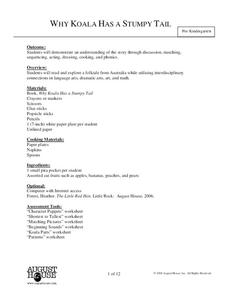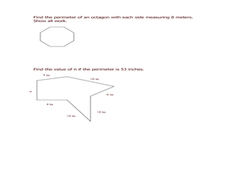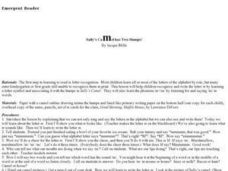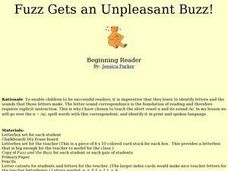Curated OER
Born to be Wild
Students watch an episode depicting the human vs. polar bear conflict in Churchill, Canada. They conduct online research and analyze the information. They interpret the facts and use storytelling techniques and role playing to convey...
Curated OER
Postcards and Greeting Cards
Learners become acquainted with traditional American holidays, monuments, sites and attractions through the review of postcards and greetings. They examine the pictures and greeting used in the cards and determine the purpose for sending...
Curated OER
Why Koala Has A Stumpy Tail
Students practice reading comprehension of an Australian folktale. In this Australian folktale lesson, students read the story, Why Koala Has a Stumpy Tail, before completing retells with character puppets, discussing friendship, and...
Curated OER
Algebra/Geometry Institute Summer 2007 - Perimeter of Polygons
Sixth graders find the perimeters of polygons and use perimeters to form polygons. In this perimeter lesson, 6th graders study vocabulary associated with finding perimeter such as polygon, line segment, variable, and formula. They make...
Curated OER
Purple Polly Platypus
First graders compare the /p/ sound to the sound of popcorn popping in the microwave and practice making the /p/. They try a tongue twister listening for the /p/ sound for the first time and then clapping when they hear the sound the...
Curated OER
Sally's Camel Has Two Humps!
First graders observe what the letter "m" looks like as it is written. They pretend to make the sound they make after eating a bowl of their favorite ice cream saying, "mmmmm" and do a cheer for the letter "m". They then look at a...
Curated OER
"HiSS"terical Snakes
Students explore the /s/ sound on the end of words. They discuss the phoneme /s/. Students listen for /s/=s at the beginning, middle and end of words. They write the letter s and practice reading and writing words containing /s/.
Curated OER
Mmmmm! Mmmmm! Yumm!
Students recognize the phoneme /m/. Through listening and matching activities, students discriminate the phoneme /m/ from similar looking letters and phonemes. They associate the phoneme /m/ with its letter representation and identify...
Curated OER
Fuzz Gets an Unpleasant Buzz
First graders recognize the short vowel u in written and spoken language. Through listening activities, they discriminate the vowel sound /u/ from other phonemes. Students associate the phoneme with its letter representation and identify...
Curated OER
Alphabetic Acting
Students recognize the short vowel a in written and spoken language. Through matching activities, they discriminate the short vowel /a/ from other vowel phonemes. Students associate the phoneme with its letter representation and identify...
Texas Education Agency (TEA)
Byzantine Architecture
View Byzantine architecture from the comfort of your classroom. A PowerPoint presentation introduces important vocabulary terms and examples of Byzantine architecture in the ninth lesson plan of the 11-part series. A Jeopardy game...
Curated OER
Thanksgiving
Students are introduced to the U.S. holiday of Thanksgiving. The lesson plan can be adapted to all ages and levels of English production ability. They recognize and define words associated with Thanksgiving.
Curated OER
The Cat in the Hat
Young scholars participate in an emerging literacy lesson in order to focus on the skill of phonemic awareness. The letter "a" is the phoneme that is chosen for letter and sound recognition in the lesson.
Curated OER
The Me Book
Learners relate to the pictures as symbols so that they come to point to named pictures, explain what pictured objects are for, match pictures to real objects, categorize objects, and recognize words.
Alabama Learning Exchange
Word a Day
Students create a word bank of sight words. Each student creates his/her own personal word bank, and creates pictures to illustrate the word.
Pennsylvania Department of Education
Writing with Beans
Students become familiar with the letters in a word by pasting beans on it. In this Bean writing instructional activity, students make words using navy beans. Students color or paint the beans.
Curated OER
Animal Alphabet
Students make a class animal book using the letters of the alphabet. They use a website imbedded in this plan to get pages with animals that begin with any of the 26 letters.
Curated OER
Egg-stra!! Egg-stra!!
Students recognize the short vowel e in written and spoken language. Through matching activities, they discriminate the short vowel /e/ from other phonemes. Students associate the phoneme with its letter representation and identify the...
Curated OER
Thump Your Thinker
First graders discuss how t and h together make one sound and then make the sound while examining the mouth movement associated with it. They listen for the sounds in sentences that are read to them before making words with the Elkonin...
Curated OER
Don't Wake the Baby - Phonics
Students explore beginning reading through the use of phonics. They practice making the /sh/ sound and create a list of /sh/ words. Students practice saying tongue twisters containing /sh/ sounds. They model writing the s and h...
Curated OER
Chuga, Chuga, Choo, Choo
Students identify the digraphs in written and spoken language. After a brief discussion on the combinations of letters that comprise digraphs, students practice identifying initial and final placement of the digraph /ch/ in words and...
Curated OER
Hop on Pop - Short 'o'
Students practice the alphabetic significance of the letter /o/ along with its awareness of phonemes in spoken words. They assess on construction paper the phrase, "We like to hop on top of Pop who's on top of a hot rock" written on it...
Curated OER
Where There's Smoke
Students view photographs to help them see how people live in rural Nepal. In groups, they imagine what it would be like to grow up in this type of community with little food and identify the problems associated with the Nepalise homes....
Curated OER
Food Dictionary - Harvest Festival
Young scholars explore healthy foods and dictionary organization. Students create a list of healthy foods. They construct their own food dictionary, with illustrations. Young scholars model how a dictionary page should be filled with...

























